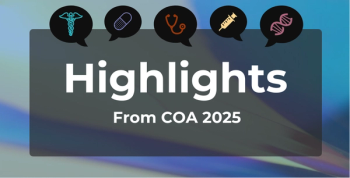
Choosing Ideal Lymphoma Regimens in the Clinic
On the first day at the annual meeting of the American Society of Clinical Oncology in Chicago, physicians introduced some of the newer agents currently available to treat lymphoma and described their experience with these agents during the session, "Incorporating Novel Agents into Lymphoma Therapy: Value in Everyday Practice."
While a number of active therapies are available to treat lymphoma, several new agents have been approved for this setting and there is a critical need to increase awareness on where these new agents fit into everyday practice and to discuss endpoint and goals of treatment. On the first day at the annual meeting of the American Society of Clinical Oncology, Chicago, physicians introduced some of the newer agents currently available and described their experience with these agents during the session, “Incorporating Novel Agents into Lymphoma Therapy: Value in Everyday Practice.”
Gilles A. Salles, MD, PhD, from the Hospices Civils de Lyon, Université Claude Bernard, introduced the audience to treatment regimens being developed for follicular lymphoma (FL). Based on the success of rituximab, several unsuccessful attempts have been made at developing anti-CD20 antibodies. Dr Salles said that a phase 2 study of ofatumumab in rituximab-refractory FL patients was conducted, but the overall response rate (ORR) was disappointing, with only 11% patients responding. A head-to-head study of rituximab vs obinutuzumab (GA101) showed no difference.
Antibodies against a few other target proteins in FL are also being developed, such as against CD22, CD80, CD74, and CD37.
A characteristic of FL, according to Dr Salles, is a defective immune response in tumors; specifically, tumor-infiltrating lymphocytes from FL have an impaired synapse formation. Treatment with lenalidomide and IMiDs (analogues of thalidomide) can abolish this effect.
Using lenalidomide as a single agent in patients with relapsed, refractory FL resulted in 27% ORR and 9% complete response (CR), said Dr Salles. The treatment can, however, cause neutropenia and may require a dose reduction of lenalidomide he added. Other commonly encountered side effects include rash, pain, and fatigue. A combination trial that evaluated lenalidomide and rituximab as frontline therapy in FL, however, has yielded much better results: ORR of 98%, 85% patients reached CR, while 13% patients had a partial response.
Moving on to talking about the most sought-after agents in oncology, Dr Salles said that T-cell activity can be blocked by inhibiting the PD-1/PD-L1 interaction. When the anti-PD-1 monoclonal antibody pidilizumab was combined with rituximab in FL, more than 50% of patients achieved ORR, which he said is very encouraging.
Some other signaling pathways being targeted in FL, he showed, include PI3K and BTK, and inhibitors against these molecules are under clinical development. For example, Dr Salles showed that idelalisib, which inhibits PI3K- d, idelalisib demonstrated rapid, durable responses and acceptable safety in highly refractory, relapsed FL patients in a phase 2 study. The study, he said, will be presented as a poster at the meeting. The results showed that ORR was 56%, and CR was 6%. Duration of response was 12.5 months and the most common adverse events were diarrhea, cough, pyrexia, fatigue, and nausea.
In the everyday practice though, Dr Salles cautioned when using these agents as first-line therapy. There are several options that can present good quality-of-life for patients he said, adding that radiation is still an option for localized disease. But toxicity and cost of these drugs needs to be considered for patients with a low tumor burden. For patients with a high tumor burden, R-CHOP with chemo is being used.
For relapsed refractory patients, autologous and allogenic transplant is an option for younger patients, while for others, chemotherapy-free regimens are a definite option.
To talk about Hodgkin lymphoma (HL) and agents developed to treat the disease was Stephen M. Ansell, MD, professor of medicine at the Mayo Clinic, Minnesota. He started his talk on a very encouraging note, saying, “These are exciting times for Hodgkin lymphoma.”
HL, said Dr Ansell, has a unique histology which provides multiple targeting options: signaling pathways, cell surface receptors, intra-tumoral immune cells, and intra-tumoral cytokines.
Some of the novel agents currently being evaluated in the clinic that he talked about include the monoclonal antibody brentuximab vedotin. One such study found that brentuximab vedotin treatment resulted in 75% ORR and 34% CR, and the treatment was reasonably tolerated. When brentuximab vedotin was incorporated into the A(B)VD (Adriamycin, bleomycin, vinblastine, dacarbazine) regimen—a first-line chemotherapy regimen used in HL—a durable response rate was observed, and progression-free survival was about 80%, which is very promising.
Use of PD-1 agents has become a promising treatment approach in HL. PD-1 is expressed on activated T-cells in the tumor as well as intra-tumoral macrophages and monocytes. Using nivolumab in HL patients resulted in a 70% PR and 17% CR. Overall, said Dr Ansell, nivolumab was well-tolerated, and a durable response was observed.
When the other PD-1 inhibitor antibody, pembrolizumab was evaluated in a small study with 29 patients, a majority of patients had a good response to treatment which again was durable, he said.
Dr Ansell then talked about a few other promising agents being evaluated in the clinic such as the HDAC (histone deacetylase) inhibitor panobinostat (LBH589), which yielded an ORR of 27% ORR.
Lenalidomide, which is used in FL patients is promising in HL as well. It targets the malignant cells, t-cells and other immune components, in addition to stromal effects.
“Multiple new approaches have promising activity in HL patients,” said Dr Ansell. “The future though is in the use of combination treatment with standard chemotherapy.”
Newsletter
Stay ahead of policy, cost, and value—subscribe to AJMC for expert insights at the intersection of clinical care and health economics.







